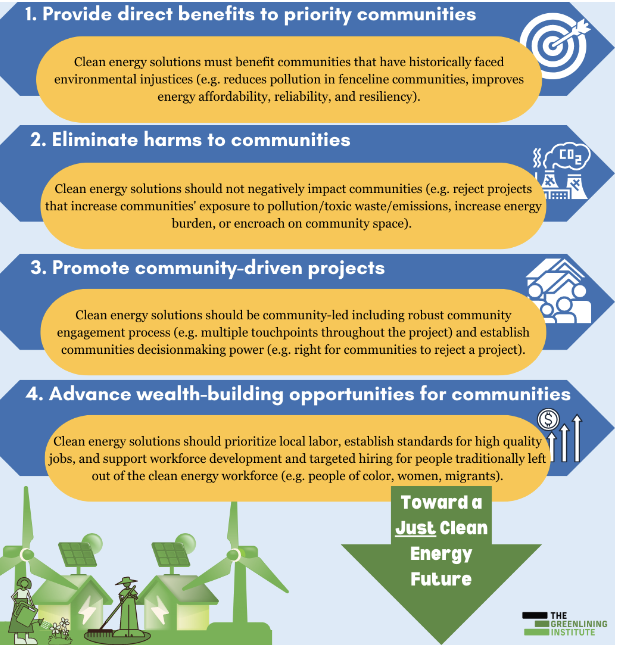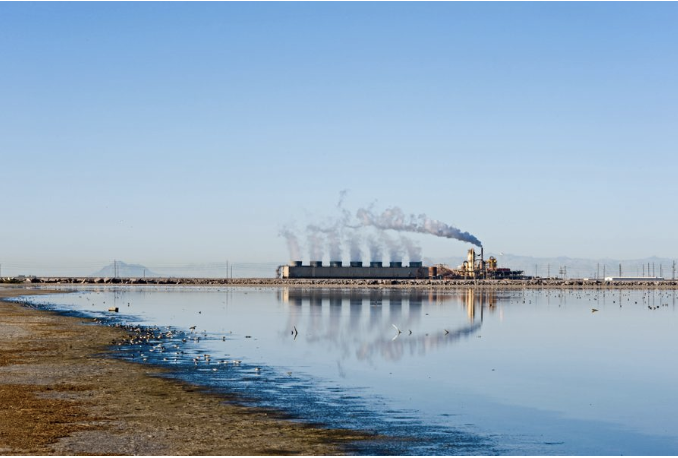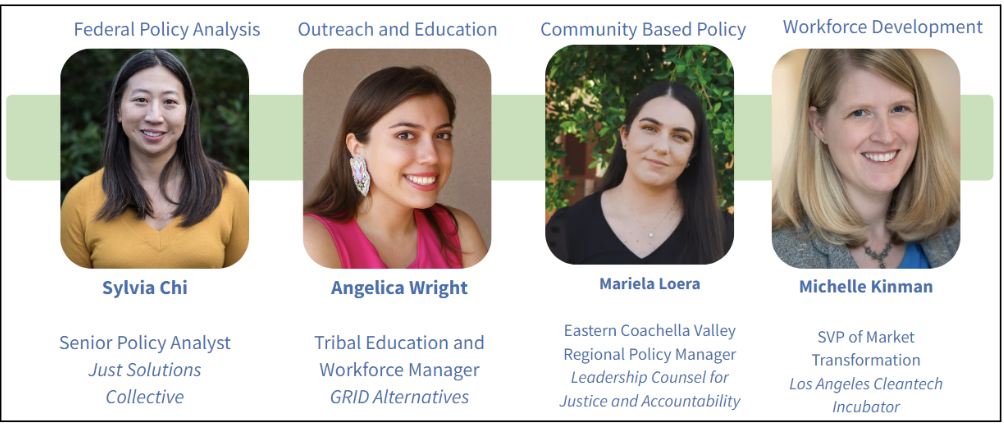Emerging Energy Technologies Part 2: Applying an Equity Framework

A just clean energy future returns power to the people to decide what energy sources are viable in their communities, how energy is generated and used, and who these technologies benefit. Now how do we get there from an energy system that for centuries has been set up to do the opposite? In Part 1 of this blog series on emerging energy technologies, I introduced four equity principles for policymakers, advocates, and program implementers to contemplate when considering whether or how to adopt trending energy technologies.

As the climate crisis worsens and communities of color disproportionately bear the brunt, we need to focus investment on proven decarbonization solutions that actually work for our communities. Shalanda Baker wrote in her book Revolutionary Power, “Just as early environmental justice advocates drew the link between toxic dumping in Black communities and civil rights, the rights to access and shape clean energy policy in service of marginalized communities should be seen as part of the corpus of civil rights.” Our equity principles are a way to evaluate how well those rights are being maintained. In Part 2 of the blog series, we will assess the need for these technologies and dive into an analysis of how the development of an emerging industry in California does or does not meet our equity principles.
Identifying Real Clean Energy Solutions for Communities
Rather than dedicating billions of taxpayer dollars to developing technology markets that may hold a climate solution, there is immense value in focusing on clean energy solutions that are already proven to reduce emissions, and that communities want.
Let’s take the solar industry for example. There is still a lot of work needed to ensure equitable access and economic opportunities with solar; we know that people of color still disproportionately adopt solar PV at lower rates and Black workers are underrepresented in the solar industry. In June, the DOE announced the nationwide $7 billion Solar for All grant competition that will fund low-income solar programs – a start, but to put it in perspective, meeting just California’s 100% clean energy goals by 2045 will cost an estimated $66 billion dollars, much of which is just on solar and storage. Meanwhile, community solar programs remain underinvested by the state of California despite being a stated priority for communities of color to access reliable clean energy, reduced energy bills, improved economic and job opportunities, and increased energy independence.
While we see a growing need for full-scale investments into equitable clean energy solutions like solar, we’re also seeing a surge of interest in emerging energy technologies that may not be equitable.
As an example, the Biden administration is investing billions of dollars to support the domestication of battery supply chains, including the mining of critical minerals like lithium–a practice historically linked with exploitation. This is the case at Lithium Valley, the site of California’s “new gold” for the country’s clean energy transition, which presents a case of both caution and opportunity to consider with the use of a new method for recovering lithium. With this emerging industry already developing in marginalized communities, we chose Lithium Valley to apply our energy equity principles and assess how the project has progressed so far, and what can be improved moving forward.
Applying Energy Equity Principles: A Look at California’s Lithium Valley
Lithium Valley in the Salton Sea region of California is advertised as the new hub for the clean energy industry—not only is it one of the world’s largest deposits of lithium, but will also be a home to the growing battery and EV industries, all while promising to reinvest in the economically underserved region its located in. Many of the communities within Lithium Valley have large Latinx populations that are exposed to multiple sources of pollution, and are classified as Disadvantaged under DOE’s CEJST tool. This will also be the site of one of the first large-scale demonstrations of direct lithium extraction (DLE), a process of recovering lithium from the brine of geothermal power plants, which is lauded to be far less environmentally damaging than traditional methods of lithium mining.

Our first equity principle is to ensure direct benefits to priority populations. Lithium Valley is being touted for the economic opportunities it will purportedly bring to a region that suffers some of the highest unemployment rates in the state. These projects could potentially provide a direct investment of lithium revenue into much-needed community infrastructure, EV charging, and air quality improvement projects through the lithium extraction excise tax. But there is an understandable wariness that communities feel given the U.S.’s exploitive history with critical minerals and a potentially predatory field of developers, startups, and those concerned with profit over people and the environment.
DLE is also an untested technology whose impacts on the community are still largely unknown. Local organizations like the Leadership Counsel for Justice and Accountability have expressed concerns about the technologies’ high freshwater and energy use and unclear waste management practices. Furthermore, tribes in the region have raised concerns that construction would disrupt their cultural sacred sites. If these concerns go unaddressed, this would violate our second equity principle of ensuring no further harm is done to communities. Having governing bodies lead at the pace of communities’ approval is imperative to ensure the development of Lithium Valley doesn’t negatively impact communities, especially with the results of the Health Impact Assessments and Environmental Impact Reports expected later in 2024.
Our third equity principle is promoting community-driven projects. While there have been public meetings held throughout the process, residents and advocates have voiced concerns about the project moving fast without their input; “We ask all government agencies to work with the entire community, not just a select few, on plans and policies that will affect all of us”. It begs the question, if the results of the Health Impact Assessments are unacceptable to communities, will affected community members have the power to shut down this multi-industry vision for Lithium Valley knowing that it will further impact a community that already suffers from pollution and disinvestment?
Our last equity principle, advancing community wealth-building opportunities, requires a careful analysis of how the lithium tax will reinvest in community improvement projects. Some local organizations under the Lithium Valley Community Coalition have been supportive of the local workforce initiatives and community benefits projects, but transparency and accountability from local government and developers is needed throughout the development process. Assemblymember Garcia, whose district encompasses the Salton Sea, has been working towards this by pushing legislation to establish both a governing office for Lithium Valley and an Equitable Access Program that will prioritize local employment opportunities for Lithium Valley. These ongoing legislative efforts are good first steps but will require continuous oversight to ensure the impact matches the intent.
Examining the promise of Lithium Valley through the lens of our equity principles shows there is still much work to be done to ensure this project equitably delivers on its vision.
But while lithium has been deemed critical to support the exponential buildout of our clean energy transition, this isn’t the only way forward. Policymakers can harness the same momentum around technological innovation to advance strategies that reduce lithium demand like developing alternative battery chemistry solutions, creating better methods for lithium-ion battery recycling, and promoting equitable public transit solutions. There are other options worth exploring besides continuing practices that may harm communities.
Policymakers, energy project developers, and government agencies should use these equity principles as a starting point to analyze whether to move forward with a project. As we work towards a just clean energy future, an energy project that doesn’t center the needs of the communities that have historically been shut out of the decision making process, will continue to perpetuate systemic harms and should be examined carefully before critical and limited resources are invested.

If you’re interested in continuing this conversation, register now for Greenlining’s 2023 Just Future Summit where we will host a panel of experts to discuss Equity Solutions or Problems? Emerging Technologies in a Just Clean Energy Transition.
— — —



